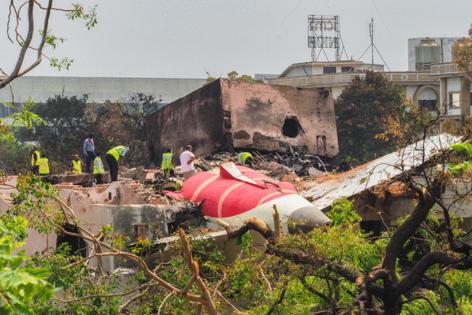3 weeks after Air India Boeing 787 crash, industry waiting for answers
Published in Business News
Three weeks after an Air India Boeing 787 crashed into a medical hostel in the northwestern Indian city of Ahmedabad, killing 241 of the 242 people on board and likely more than a dozen on the ground, investigators are piecing together what went wrong.
Aviation regulators from India, the U.S. and the U.K., where the London-bound flight was headed, are studying the plane’s data recorders for clues about the flight’s final moments. Investigators have yet to release any preliminary findings to explain why the plane seemingly lost thrust less than a minute after takeoff.
Aviation safety experts have begun to narrow their thinking as they review photos and videos of the brief flight and the crash site, and consider possible explanations for what went wrong.
Experts appear to be in agreement on some facts: The flaps and slats on the wings were likely in the correct positions. The engines lost power. And it’s not clear why.
They are split on other questions, mainly what it means for Boeing and engine maker General Electric Aerospace that safety regulators have not called for additional action on other 787s or planes with the GEnx engine. Some say that suggests the crash does not indicate a systemwide concern, while others say it signals only that investigators haven’t yet decided what to do.
“It’s too early to conclude any definitive causes,” said Chad Kendall, a former pilot, Federal Aviation Administration instructor and aviation professor at Metropolitan State University of Denver.
“While Boeing’s stock and reputation have taken a big hit, the biggest test lies ahead,” Kendall said. “Is this a worst-case systemic finding, or an isolated pilot, maintenance misstep?”
At this stage, Kendall continued, “everything is on the table.”
Boeing and GE are limited in what they can say during the investigation, but both companies said they are prepared to support Air India and assist in the investigation. Hours after the crash, Boeing CEO Kelly Ortberg said in a statement: “Our deepest condolences go out to the loved ones of the passengers and crew on board Air India Flight 171, as well as everyone affected in Ahmedabad.”
Investigating the data
Boeing’s 787 has two so-called black boxes, one in the nose of the plane and one in the tail.
Those boxes are a combination of two types of recorders, Kendall said: the cockpit voice recorder, which tracks audio and other sounds in the flight deck, and the flight data recorder, which keeps a record of aircraft systems and flight parameters, including airspeed and altitude.
The black boxes on Air India Flight 171 have been moved to a secure site in Delhi, where investigators are starting the process of extracting flight data and piecing together at least 88 data points that the machines collect. Boeing and GE, which makes the engines and black boxes on the 787, are assisting, Kendall said.
Kendall related the whole process to unspooling a ball of yarn — investigators will have a lot of data to unravel.
Kendall expects it is taking longer than other incidents to start getting some answers because the black boxes are severely damaged. They are designed to withstand a major amount of force and are “self-contained,” meaning they have internal batteries to keep gathering data even if other systems on the plane malfunction. But, if they are damaged, there are extra steps in the process of unlocking their records, Kendall continued, such as cutting the boxes open and removing the memory boards.
It could be more than a year before investigators determine the probable cause of the crash, but Kendall said he expects they will release small pieces of information in the meantime, including a transcript of the cockpit voice recorder.
A loss of power
While there’s still no definitive answer about what went wrong, the list of possibilities appears to be shrinking, with experts taking some initial theories off the table and focusing more intently on others.
At this point, “there is every indication that there was a power loss on both engines,” said John Nance, a former pilot with the Air Force and Alaska Airlines who has written several books on aviation safety.
That’s been suspected since the first days after the crash, as experts scrambled to look for clues to explain why the airplane suddenly lost thrust and stopped climbing. Nance pointed to new developments that further solidify the theory.
First, a small turbine that acts as a backup energy source on the 787 appears to have deployed. That device, known as the Ram Air Turbine, or RAT, would indicate a loss of power.
Second, analysis appears to rule out one of the prominent, early hypotheses related to the position of the flaps on the airplane’s wing, Nance said.
Flaps are movable panels along the plane’s wings that provide lift. Early on, some observers wondered whether the flaps were positioned incorrectly, without knowing what might have caused that scenario.
But, Nance said, an informal report he received this week indicated the flaps were correctly positioned.
Furthermore, investigators using a simulator to re-create the flight path and circumstances of the crash have shown that even if the flaps were in the wrong position, the plane still could have stayed in the air, Nance said.
It also appears the pilots did attempt to retract the landing gear, another early point of speculation. Photos from the crash appear to show the wheels of the landing gear positioned to start being tucked back into the plane. But, Nance said, the loss of power may have stopped that from happening.
“I think what’s coming next is an indication from the investigative team … that the cause of the lack of thrust was ‘fill in the blank,’” Nance said. “It may not be fully explanatory, but that’s where all the attention is.”
Bjorn Fehrm, an analyst with the aviation consulting firm Leeham News, agreed that new analysis of the plane’s final seconds seems to rule out a problem with the position of the flaps and slats, another panel on the opposite side of the wing.
“The only thing that remains is a real big problem with the engines, where they stopped producing thrust and also hydraulic power and electrical power,” Fehrm said. “Or there was a major electric or hydraulic failure in the aircraft.”
Fehrm still has a long list of what could have caused those failures, including pilot error and fuel contamination. He also floated the possibility of “vapor lock,” which occurs when temperatures are so high that fuel turns into gas. That one has a low probability because there haven’t been reports of extreme heat.
All together, Fehrm said he believes it “less likely” that there was “an aircraft problem.”
An unexplained dual-engine failure
There is a puzzling wrinkle that Nance and his aviation peers keep coming back to, the former pilot said.
A dual-engine failure is extremely rare because the engines, by design, operate independently. Whatever happens to disrupt one engine doesn’t necessarily happen to the other. That’s a safety feature, Nance said, meant to protect against one malfunction bringing the whole plane down. Most airplanes, including the 787, can safely fly with just one engine.
“The left and right (engine) do not communicate, not in the way that they could create an accident,” Nance said. “That’s part of the philosophy — everything is as independent as you can get it.”
In the rare circumstance where there is a dual-engine failure, investigators would turn first to outside factors, including lightning or a bird strike. But there’s no indication that external conditions affected the Air India flight.
Without ruling out any possibility entirely, Nance said that points to a problem with the engine controls. That could mean a problem with the airplane design or its use, Nance continued, but it's too soon to know.
787s still flying
Air India has inspected at least 26 of its 33 Boeing planes and cleared all of those to return to service, according to the airline’s last major update on its fleet two weeks ago.
At that time, the airline said it was expanding inspections to its fleet of Boeing 777 planes, “as a matter of added precaution.”
India’s aviation regulator, the Directorate General of Civil Aviation, said in June the initial 787 inspections had not revealed any major safety concerns, adding that inspections were ongoing.
So far, aviation authorities have not issued any directives for other airlines to inspect their 787s or planes with the same GE engines as the one that went down. Authorities also haven’t recommended grounding the 787 fleet.
Fehrm called that a “cautious positive.”
He expects investigators have a “reasonably good idea” of what has happened, even if they haven’t shared it. The fact that there haven’t been any emergency directives, Fehrm said, “speaks against it being a problem with Boeing and GE.
Nance said the lack of emergency action isn’t indicative one way or the other. To him, it simply means it’s too soon to know. Without knowing more specifics about the cause, regulators wouldn’t know what to tell airlines to look for in those inspections.
Kendall, from Metropolitan State University of Denver, said if the investigation, at any point, uncovers a systemic concern, aviation regulators would act on that immediately — even before determining a final cause.
“It’s very important for the public to understand … if there’s anything that needs to be addressed right now, it’s going to come out,” Kendall said. “An investigation is a proactive process, and safety is a proactive process.”
©2025 The Seattle Times. Visit seattletimes.com. Distributed by Tribune Content Agency, LLC.












Comments